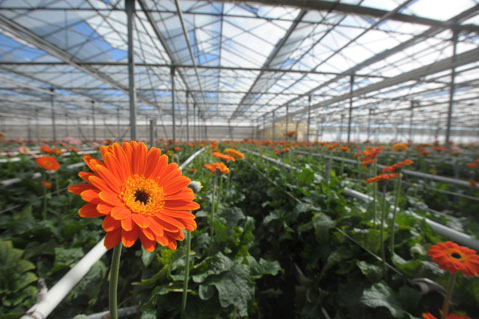Flower Power
How Carp Valley Agriculture Was Preserved

Land-use battles waged in the 1970s determined to a great degree the look and feel of the South Coast today. In that decade, the prospect of urban sprawl along Gaviota and within the Carpinteria Valley was eliminated, and the residential density allowed in Santa Barbara was reduced by half. These important milestones take us back to a time when the county was the epicenter of the modern environmental movement that has cast its influence far and wide since those frothy days.
One quiet tale of land preservation — to protect the Carpinteria Valley as an agricultural resource —played out almost entirely without public controversy. In 1972, an environmentally aroused public that had recently witnessed the devastation of the 1969 Santa Barbara Oil Spill ran a successful initiative that created the California Coastal Commission. The Commission’s task was “to protect, conserve, restore and enhance the environment of the California coastline” stretching some 1,100 miles from Oregon to Mexico.
At the instigation of 2nd District supervisor Robert “Bob” Kallman, Santa Barbara County sought and received funding to prepare the state’s first Local Coastal Plan. One of the most challenging tasks of this plan was to find a way to preserve agriculture in Carpinteria Valley (excluding the City of Carpinteria), about six miles in length and two miles wide. The area was in the path of urbanization and contained a maze of small parcels planted with avocado and lemon trees, along with nurseries and greenhouses. A small group of planners, economists, and systems experts was hired to prepare the plan for the entire county, including the Channel Islands.
Unraveling a way to protect the Carpinteria Valley was like untying a Gordian knot. Some of the agricultural lands were protected under the Williamson Act, which allowed owners to sign contracts to maintain their agricultural use. In return, the owners were taxed at commensurate rates, but participation in these contracts was spotty. The Williamson Act couldn’t guarantee that the land would be maintained as agriculture for the long haul, as envisioned by the California Coastal Act.
There was the added complexity of how to deal with greenhouses. Because they often grew plants in artificial media on concrete floors, were lit at night to force flowers to bloom, and included large loading docks and paved driveways, some argued they were more industrial than agricultural in nature. Although the study team had considerable expertise from a planning perspective, they were untutored in the ways of greenhouse cultivation or how large parcels needed to be to be considered “agriculturally viable.”
The greenhouse growers were, and remain to this day, predominately Dutch American. Ironically, many came to the Carpinteria Valley to get away from government regulations that put them out of business in the Netherlands. On the South Coast, they found mild temperatures and long days of sunshine, and a large flower market in nearby Los Angeles with an airport that ships flowers all over the U.S. The planning group’s initial efforts to engage the growers were met with justifiable paranoia, but as time went on, they became more cooperative when they realized the planners were trying to accommodate greenhouses rather than eliminate them.
Less helpful, unfortunately, was the University of California’s Agricultural Extension Service, whose agent assigned to the study was contemptuous of the planning process from the get-go. When asked for his recommendation of the minimum parcel size that would protect agriculture, he offered two words: “One acre.” The planners were stunned by his position, but it never wavered even as he testified before the Santa Barbara Board of Supervisors. The team ignored this “expert” advice and finalized a plan that allowed for continued greenhouse commerce.
Typical of Santa Barbara’s contested land-use issues, the Board of Supervisors divided north and south on whether to approve the proposal. Kallman, a conservative pillar of the community with a nursery background, held the future of the Carpinteria Valley in his hands. He rarely sided with the planners and environmental interests, but in this case, he did. Casting the decisive 3-2 vote, preservation of the Carpinteria Valley as an agricultural resource was sealed.
That lush, garden-like landscape that greets drivers on Highway 101 — and reveals its rich agricultural diversity along Highway 152 — remains much as it was more than 30 years ago, thanks to the California Coastal Act, the county planning department, and a supervisor named Bob Kallman.



